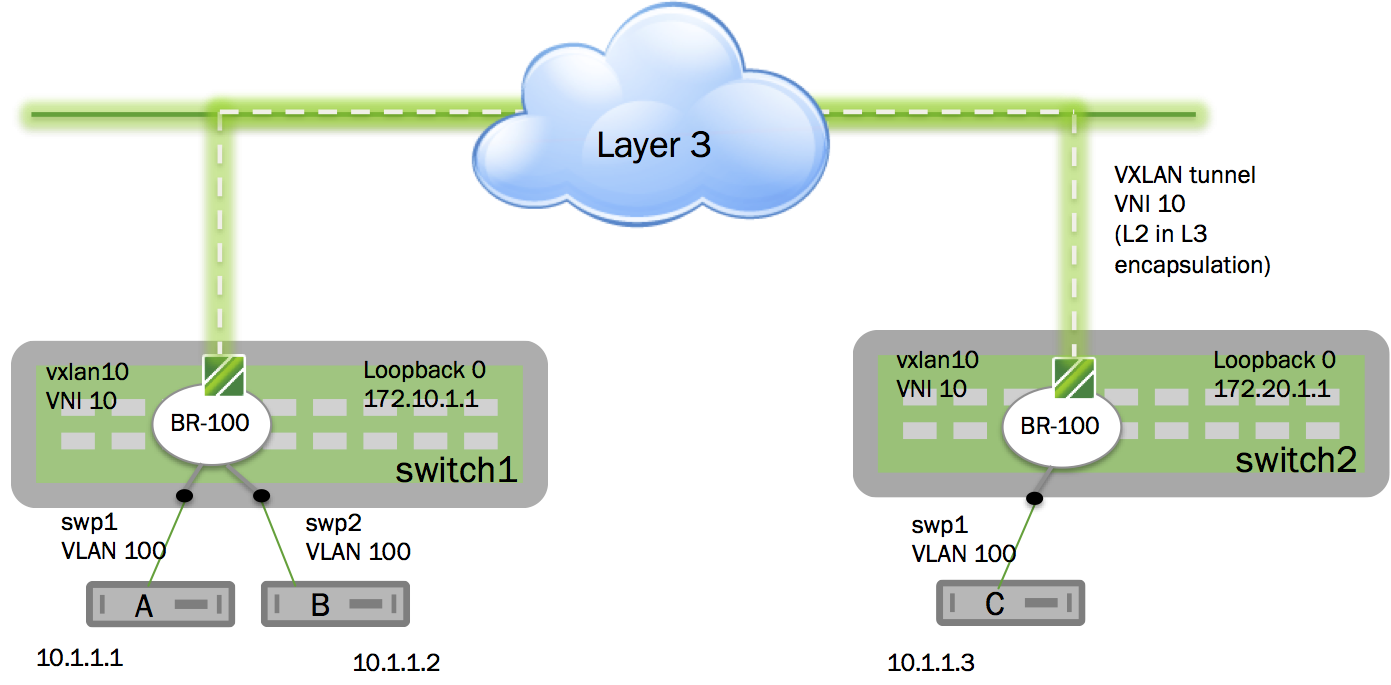Static MAC Bindings with VXLAN
Cumulus Linux includes native Linux VXLAN kernel support.
Requirements
A VXLAN configuration requires a switch with the Broadcom Tomahawk, Trident II+, or Trident II ASIC running Cumulus Linux 2.0 or later, or a switch with the Mellanox Spectrum ASIC running Cumulus Linux 3.2.0 or later.
For a basic VXLAN configuration, make sure that:
- The VXLAN has a network identifier (VNI); do not use 0 or 16777215 as the VNI ID, which are reserved values under Cumulus Linux.
- The VXLAN link and local interfaces are added to the bridge to create the association between port, VLAN, and VXLAN instance.
Example VXLAN Configuration
Consider the following example:

Configure the Static MAC Bindings VXLAN
To configure the example illustrated above, first create the following configuration on switch1:
cumulus@switch1:~$ net add loopback lo ip address 172.10.1.1
cumulus@switch1:~$ net add loopback lo vxrd-src-ip 172.10.1.1
cumulus@switch1:~$ net add bridge bridge ports swp1-2
cumulus@switch1:~$ net add bridge post-up bridge fdb add 0:00:10:00:00:0C dev vtep1000 dst 172.20.1.1 vni 1000
cumulus@switch1:~$ net add vxlan vtep1000 vxlan id 1000
cumulus@switch1:~$ net add vxlan vtep1000 vxlan local-tunnelip 172.10.1.1
cumulus@switch1:~$ net add vxlan vtep1000 bridge access 10
cumulus@switch1:~$ net pending
cumulus@switch1:~$ net commit
These commands create the following configuration in the
/etc/network/interfaces file:
auto vtep1000
iface vtep1000
vxlan-id 1000
vxlan-local-tunnelip 172.10.1.1
auto bridge
iface bridge
bridge-ports swp1 swp2 vtep1000
bridge-vids 10
bridge-vlan-aware yes
post-up bridge fdb add 0:00:10:00:00:0C dev vtep1000 dst 172.20.1.1 vni 1000
Then create the following configuration on switch2:
cumulus@switch2:~$ net add loopback lo ip address 172.20.1.1
cumulus@switch2:~$ net add loopback lo vxrd-src-ip 172.20.1.1
cumulus@switch1:~$ net add bridge bridge ports swp1-2
cumulus@switch2:~$ net add bridge post-up bridge fdb add 00:00:10:00:00:0A dev vtep1000 dst 172.10.1.1 vni 1000
cumulus@switch2:~$ net add bridge post-up bridge fdb add 00:00:10:00:00:0B dev vtep1000 dst 172.10.1.1 vni 1000
cumulus@switch2:~$ net add vxlan vtep1000 vxlan id 1000
cumulus@switch2:~$ net add vxlan vtep1000 vxlan local-tunnelip 172.10.1.1
cumulus@switch2:~$ net add vxlan vtep1000 bridge access 10
cumulus@switch2:~$ net pending
cumulus@switch2:~$ net commit
These commands create the following configuration in the
/etc/network/interfaces file:
auto vtep1000
iface vtep1000
vxlan-id 1000
vxlan-local-tunnelip 172.20.1.1
auto bridge
iface bridge
bridge-ports swp1 swp2 vtep1000
bridge-vlan-aware yes
post-up bridge fdb add 00:00:10:00:00:0A dev vtep1000 dst 172.10.1.1 vni 1000
post-up bridge fdb add 00:00:10:00:00:0B dev vtep1000 dst 172.10.1.1 vni 1000
Troubleshooting
Use the following commands to troubleshoot issues on the switch:
-
brctl showverifies the VXLAN configuration in a bridge:cumulus@switch:~$ brctl show bridge name bridge id STP enabled interfaces bridge 8000.2a179a8cc471 yes swp1 swp2 vni-10 vni-2000 -
bridge fdb showdisplays the list of MAC addresses in an FDB:cumulus@switch1:~$ bridge fdb show 44:38:39:00:00:18 dev swp1 master bridge permanent 44:38:39:00:00:1c dev swp2 master bridge permanent 2a:17:9a:8c:c4:71 dev vni-2000 master bridge permanent 9a:e8:ef:a1:9d:6f dev vni-10 master bridge permanent 00:00:10:00:00:0c dev vni-10 dst 172.20.1.1 self permanent -
ip -d link showdisplays information about the VXLAN link:cumulus@switch1:~$ ip -d link show vni-10 15: vni-10: <BROADCAST,MULTICAST,UP,LOWER_UP> mtu 1500 qdisc noqueue master bridge state UNKNOWN mode DEFAULT group default link/ether 9a:e8:ef:a1:9d:6f brd ff:ff:ff:ff:ff:ff promiscuity 1 vxlan id 10 remote 10.2.1.3 local 10.2.1.1 srcport 0 0 dstport 4789 ageing 1800 bridge_slave state forwarding priority 8 cost 100 hairpin off guard off root_block off fastleave off learning on flood on port_id 0x8004 port_no 0x4 designated_port 32772 designated_cost 0 designated_bridge 8000.2a:17:9a:8c:c4:71 designated_root 8000.2a:17:9a:8c:c4:71 hold_timer 0.00 message_age_timer 0.00 forward_delay_timer 0.00 topology_change_ack 0 config_pending 0 proxy_arp off proxy_arp_wifi off mcast_router 1 mcast_fast_leave off mcast_flood on addrgenmode eui64